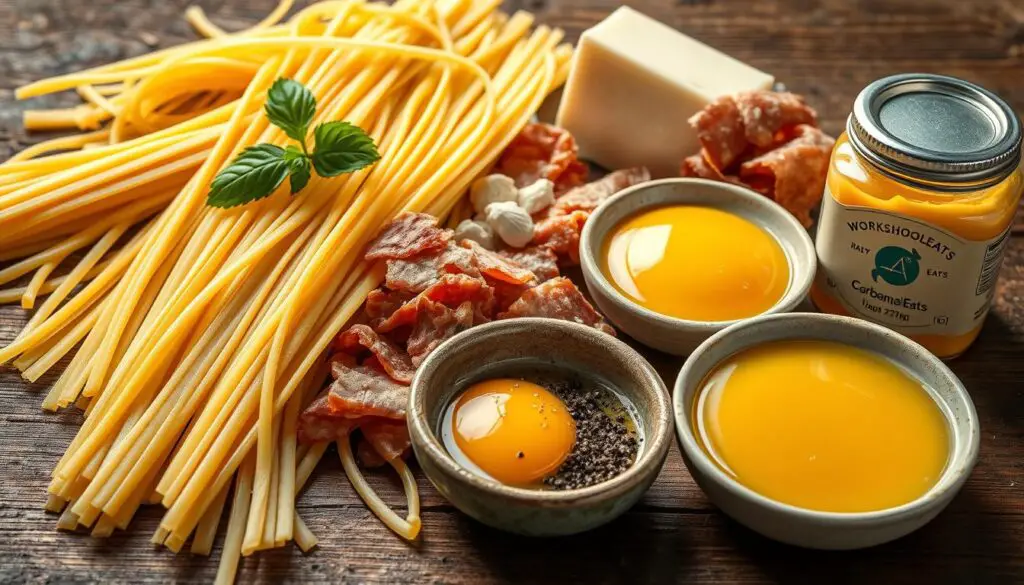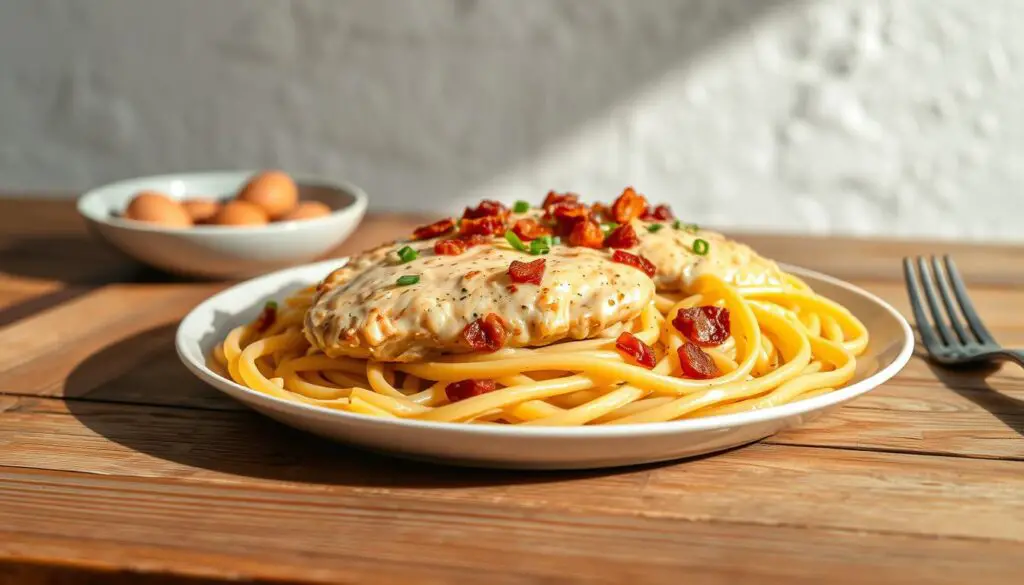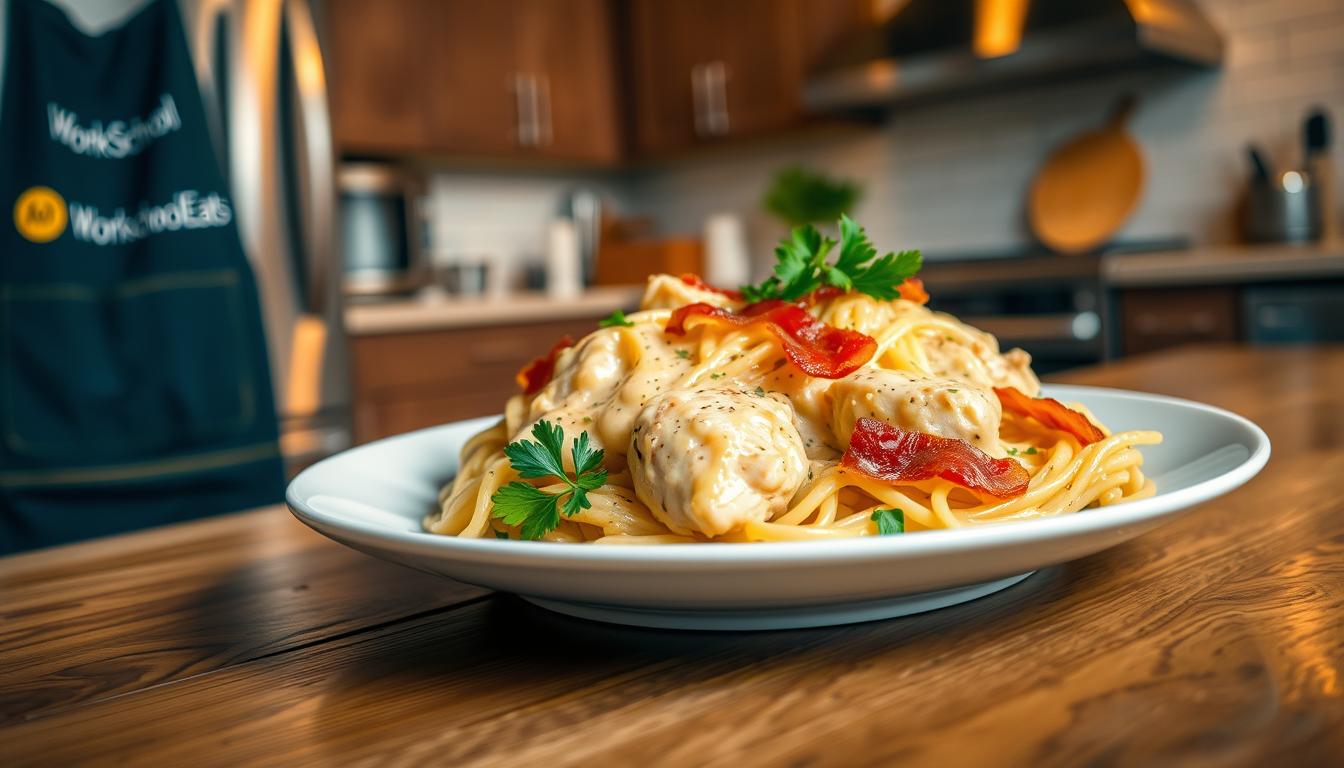Imagine this: it’s Friday evening, and the last thing you want is a complicated dinner. You crave something rich, comforting, and ready in under an hour. Enter the chicken carbonara recipe—a dish where creamy pasta, savory chicken, and a hint of pepper come together in just 45 minutes. This isn’t just a meal; it’s a weeknight savior that blends Italian tradition with practical modernity. No need for a fancy kitchen—just a skillet, a pot of boiling water, and 10 minutes of prep.
Key Takeaways
- Ready in 45-50 minutes with just 10-15 minutes of hands-on prep.
- Serves 4-6 people with a balance of protein and carbs.
- Uses pantry staples like eggs, Parmesan, and pancetta for authentic flavor.
- Perfect for weeknights without sacrificing gourmet taste.
- Simple steps to achieve that signature creamy sauce without heavy cream.
Table of Contents
Introduction: Discover the Delicious Chicken Carbonara
Italian chicken carbonara is more than a meal—it’s a celebration of Italian culinary artistry. This dish blends rustic simplicity with rich flavors, making it a timeless favorite. Its origins trace back to Rome, where traditional recipes rely on pantry staples transformed into something extraordinary.
Overview of the Dish
This pasta dish centers on four pillars: egg, Pecorino Romano, guanciale or bacon, and starchy pasta like spaghetti. The sauce forms through emulsification, where hot pasta gently cooks raw eggs without curdling. The result? A velvety coating that clings to every noodle.

What Makes It Special
- Authentic Technique: Searing meat in its own fat adds depth, while off-heat mixing prevents scrambled eggs.
- Umami Layers: Cured pork like pancetta releases savory umami, balanced by sharp Pecorino.
- No cream: The “creamy” texture comes purely from egg yolks and cheese, making it a purist’s choice.
Its simplicity hides complexity—every ingredient plays a role. Master this balance, and you’ll understand why Italian chicken carbonara remains a global comfort food icon.
Essential Ingredients for Your Chicken Carbonara Recipe
Creating the perfect classic carbonara chicken pasta starts with the right ingredients. Each component plays a key role in achieving that signature rich and creamy flavor. Let’s break down what you need to master this dish.

Fresh Poultry and Pasta
Choose boneless, skinless chicken breast or tenderloins for a tender base. Opt for rigatoni pasta—the ridges cling to the sauce better than smooth pasta shapes. Always cook the pasta al dente, reserving some pasta water to adjust the sauce later.
Dairy and Seasoning Essentials
No shortcuts here: fresh eggs and Pecorino Romano cheese create the classic carbonara’s creamy texture without heavy cream. Use high-quality ingredients:
- Pancetta or guanciale: Cured pork adds savory depth.
- Whole eggs and yolks: Whisked with cheese to bind the sauce.
- Pecorino Romano: Sharp, salty cheese balances richness.
- Black pepper: Freshly cracked for a peppery kick.
Pro tip: Never use pre-shredded cheese—it oxidizes faster. Grate it fresh for maximum flavor.
Step-by-Step Cooking Process

Creating homemade chicken carbonara demands precision to avoid overcooking or separating sauces. Follow this sequence to balance heat and ingredients:
Preparing the Ingredients
Start by prepping all components. Dice pancetta into ½-inch cubes, slice chicken breasts into strips, and grate pecorino romano cheese. Whisk eggs in a bowl and set aside at room temperature. Boil salted water for pasta, ensuring it’s ready when ingredients are prepped.
Cooking Techniques and Timing
| Step | Action | Time |
|---|---|---|
| 1 | Sauté pancetta until translucent, retaining its fat | 4-5 minutes |
| 2 | Cook chicken in pancetta fat until opaque | 3-4 minutes per side |
| 3 | Drain pasta, reserving ½ cup water | 1 minute |
| 4 | Mix hot pasta with egg-cheese blend off the heat | 30 seconds |
Never stir sauce directly over heat once eggs are added.
Combine pasta with the egg and cheese mixture immediately after cooking. Toss gently to coat, adding reserved pasta water if too thick. Season with cracked pepper and a squeeze of lemon for brightness.
Tips for Perfecting Authentic Chicken Carbonara
Mastering the creamy chicken carbonara starts with precision. Follow these techniques to avoid common mistakes and achieve that velvety texture:
- Low Heat Mastery: Remove the pan from heat before combining egg mixture with hot pasta. This prevents scrambled eggs and ensures a smooth sauce.
- Pasta Water Magic: Reserve ½ cup pasta water. Stir small amounts into the sauce to adjust consistency—thin it if too thick, thicken if too loose.
- Egg Emulsification: Stir vigorously when blending egg and pasta. The emulsion forms best when ingredients are warm but not boiling.
“The secret is patience—the sauce must marry egg, cheese, and pasta without fear of overcooking.” — Roman culinary tradition
Always use freshly cracked black pepper for brightness. Overcooking the eggs turns the sauce grainy. For an extra layer of richness, add a spoonful of creamy chicken carbonara sauce back into the egg mix before combining. Serve immediately to preserve that signature silky mouthfeel.
Homemade vs. Traditional Chicken Carbonara
Choosing between homemade or traditional methods shapes your easy chicken carbonara recipe. Let’s break down how techniques and ingredients impact your dish.
Comparing Techniques
- Traditional: Simmers eggs slowly with cheese for silky sauce
- Homemade: Often uses quicker stirring methods for simplicity
Flavor Differences
| Aspect | Traditional | Homemade |
|---|---|---|
| Pancetta | Cured guanciale for smoky depth | Bacon or turkey for mild taste |
| Creaminess | No cream—reliant on egg emulsification | May add milk or cream for comfort |
Texture and Consistency
Traditional versions feature pasta coated in velvety sauce. Homemade easy chicken carbonara recipe might have a lighter, looser texture. Both styles rely on al dente pasta to balance richness.
“The best carbonara adapts to your kitchen—authenticity is in the balance,” says Chef Marco Rossi of Rome’s L’Arco D’Oro.
Experiment with ingredient swaps while keeping egg safety top priority. Whether you follow tradition or streamline steps, focus on fresh eggs and high-quality cheese for depth.
Easy Chicken Carbonara Recipe for Busy Weeknights
Enjoy authentic chicken carbonara in under 30 minutes with these time-smart tricks. Skip the hassle of last-minute prep by pre-chopping ingredients and storing them in airtight containers. Marinate chicken in olive oil and spices earlier in the day for tender results without extra effort.
- Use pre-cooked chicken breast for a 10-minute shortcut
- Pre-boil pasta 15 minutes before starting the sauce
- Store Parmesan in the freezer for quick grating
Cook eggs and cheese over low heat in a skillet—no double boilers required. Whisk yolks and cheese constantly until creamy, then toss with pasta immediately. This method retains the authentic chicken carbonara silkiness without complicated techniques. Pair with garlic bread for a complete meal.
“The key to weeknight authenticity is respecting tradition without rigidity,” says Chef Marco Rossi of Rome’s Carbonara Academy. “Prioritize quality ingredients over lengthy prep.”
Freeze unused egg yolks in ice cube trays for future batches. Batch-cook bacon or pancetta on Sundays for weekday use. Even with shortcuts, this recipe honors the dish’s origins by avoiding cream—true authentic chicken carbonara relies on egg emulsification. Serve immediately for optimal flavor and texture.
Italian Chicken Carbonara: Fusing Classic Flavors
Italian cuisine thrives on tradition, but innovation keeps dishes like chicken carbonara fresh. Explore how regional Italian techniques and modern creativity shape this beloved pasta. The delicious chicken carbonara balances heritage and new ideas, creating a dish that’s both comforting and exciting.
Regional Influences
Authentic recipes vary by region. Roman versions emphasize Pecorino Romano cheese and cured guanciale, while southern Italy might use local meats like pancetta. These differences highlight how geography shapes taste. Each region’s approach respects the dish’s roots while adding local flair.
Modern Twists on Tradition
Bring your plate into the 21st century with these updates:
- Add grilled zucchini or mushrooms for a vegetable boost
- Swap chicken breast for shrimp or tofu for texture changes
- Try truffle oil or chili flakes for bold accents
Mixing old and new lets you honor tradition while making the delicious chicken carbonara your own. Whether sticking to Roman standards or adding modern touches, the key is balancing rich flavors without overwhelming the dish’s core elements.
Exploring Classic Carbonara Chicken Pasta Variations
While traditional chicken carbonara remains a timeless favorite, experimenting with its base recipe lets you adapt it to modern tastes. Try grilling zucchini slices and tossing them into the pasta for a smoky twist. For a lighter option, swap pasta for spiralized spaghetti squash, maintaining the creamy sauce’s richness without the carbs.
- Vegetable-Infused: Add roasted mushrooms or asparagus to balance protein and fiber.
- Pizza Edition: Spread carbonara sauce on a crispy pizza base topped with chicken and arugula.
- Low-Carb: Use shirataki noodles for a keto-friendly version that still mimics pasta’s texture.
“The key to variations is respecting the dish’s soul—creamy, savory, and unapologetically indulgent.”
Pairing these updates with the traditional chicken carbonara base ensures no flavor compromise. Whether you’re cutting carbs or craving a veggie boost, creativity keeps meals exciting. These adaptations work best when the original recipe’s balance of egg, cheese, and pepper stays intact.
Creamy Chicken Carbonara: Rich and Decadent
The chicken carbonara recipe shines with its velvety sauce. Achieving that silky texture relies on simple ingredients and precise technique. Here’s how to master the balance of richness and flavor.
The Secret Behind the Creaminess
- Use egg yolks and Pecorino Romano cheese as your base. These create a creamy foundation without added dairy.
- Reserve pasta water! The starch from the water helps bind the sauce when mixing in eggs and cheese.
- Never rush the process. Stir slowly over low heat to avoid scrambling the eggs.
Balancing Flavors Perfectly
Salt, pepper, and cheese work together to avoid a one-note dish. Start with lightly salted pasta water, then add freshly cracked black pepper. Taste the cheese before adding extra salt—the right blend prevents the sauce from tasting flat or overly rich.
For a modern twist, drizzle with a hint of lemon zest to brighten the dish. The goal? A sauce that coats each bite without overwhelming the chicken’s natural flavors. This is authentic carbonara sauce done right.
Authentic Chicken Carbonara: Mastering the Tradition
Creating an authentic Chicken Carbonara means respecting the dish’s origins. Every step from selecting ingredients to cooking methods matters. These tips ensure your meal stays true to its Italian roots.
Time-Honored Techniques
Start by using guanciale instead of bacon—it’s key to the dish’s heritage. Cook pasta in salted water until al dente. Never rinse it afterward. Combine eggs and cheese off the stove to avoid scrambling.
Essential Tips for Success
- Use Pecorino Romano cheese for that sharp, traditional flavor.
- Temper the eggs by mixing them with hot pasta water before adding to the pan.
- Stir gently to coat pasta without overmixing.
| Technique | Why It Matters |
|---|---|
| No cream | Authentic recipes avoid dairy thickening agents. |
| Pan emulsification | Creates a silky sauce naturally. |
Chefs in Rome emphasize patience. Let the dish rest briefly before serving. This lets flavors meld. Mastering these steps honors the dish’s legacy while ensuring each bite bursts with genuine Italian taste.
Conclusion
Chicken Carbonara isn’t just a meal—it’s a celebration of simplicity and tradition. By following the steps outlined, you’ve seen how fresh ingredients like quality pasta, eggs, and Pecorino Romano come together to create a dish that’s both comforting and sophisticated. Whether you’re a home cook or a weeknight chef, this recipe balances classic Italian techniques with modern convenience.
Remember the core elements: never boil pasta in salted water, avoid cream for authenticity, and master the emulsion with eggs and cheese. These tips ensure a velvety sauce without overcomplicating the process. The result? A dish that’s rich in flavor but approachable enough for busy evenings.
Explore variations like adding guanciale or pancetta if you prefer traditional meats, or opt for bacon for a familiar twist. Sharing this meal with family or friends highlights its universal appeal—proof that great food doesn’t need to be complicated. Next time you crave a hearty meal, turn to this trusted method. Your taste buds—and your kitchen routine—will thank you.

